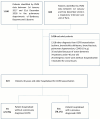Factors associated with undiagnosed COPD in patients hospitalised for severe COPD exacerbation
- PMID: 39608870
- PMCID: PMC11603825
- DOI: 10.1136/bmjresp-2024-002620
Factors associated with undiagnosed COPD in patients hospitalised for severe COPD exacerbation
Abstract
Background: Studies suggest that up to 70% of chronic obstructive pulmonary disease (COPD) cases globally are undiagnosed worldwide. Some of these undiagnosed patients may present with severe exacerbation and factors associated with underdiagnosis in this population are unknown. We investigated the key factors associated with underdiagnosis in two cohorts of patients hospitalised for severe COPD exacerbation at different time points.
Methods: This retrospective, multicentre study analysed data from patients hospitalised for COPD exacerbation at two independent centres during two distinct time periods: between 1 January 2017 and 31 December 2018 in the Aquitaine region and between 1 January and 31 December 2022 in Paris. Undiagnosed COPD was defined as the absence of pulmonary function testing before the index exacerbation. Multivariate logistic regression was used to evaluate associations between underdiagnosis and patient characteristics.
Results: Among the 424 patients, 93 (21.9%) were undiagnosed before hospitalisation, with a stable rate over time (22% in 2017-2018 and 21% in 2022). Multivariate analysis revealed that underdiagnosis was related to higher forced expiratory volume in one second (FEV1; adjusted OR (aOR)=1.02, p=0.043) and female sex (aOR=1.91, p=0.015). Patients with undiagnosed COPD had significantly lower rehospitalisation and mortality rates. After the initial severe exacerbation, higher mortality was associated with a higher Charlson Comorbidity Index (HR=1.24, p=0.007) and older age (HR=1.05, p=0.008).
Conclusion: This retrospective, multicentre study demonstrated that about 20% of patients admitted with severe exacerbation were undiagnosed for COPD. Higher FEV1 and female sex were associated with underdiagnosis, emphasising the need for special attention to this population. These findings highlight the need to improve training and access to spirometry and develop new diagnostic tools that facilitate earlier detection and management of COPD.
Keywords: COPD Exacerbations; COPD epidemiology.
© Author(s) (or their employer(s)) 2024. Re-use permitted under CC BY-NC. No commercial re-use. See rights and permissions. Published by BMJ.
Conflict of interest statement
Competing interests: MG, EK, GV and LP have no conflicts of interest to disclose. CN-E reports grants and personal fees from GSK, Sanofi, AstraZeneca, Chiesi, ALK and Menarini outside the submitted work. JM has no conflicts of interest to declare. LG has no conflict of interest to declare related to the present work. He received grants from AADAIRC. He received speaker or advisory board fees from GSK, Asten, Air Liquide Medical System, Sanofi Genzyme, SOS Oxygène, AstraZeneca, ASV, Boehringer, VIVISOL and ResMed and support for attending the meeting from SOS Oxygène, Alize Santé and Asten. TS reports personal fees from Menarini, Sanofi, Chiesi, AstraZeneca, GSK outside the submitted work. MZ reports grants and personal fees from Menarini, personal fees from Sanofi, personal fees from Chiesi, personal fees from AstraZeneca, personal fees from CSL Behring and personal fees from GSK outside the submitted work, grants from AVAD, grants from FRM.
Figures




References
-
- Global Initiative for Chronic Obstructive Lung Disease GOLD report. 2023. [07-Jan-2023]. https://goldcopd.org/2023-gold-report-2/ Available. Accessed.
Publication types
MeSH terms
LinkOut - more resources
Full Text Sources
Medical
